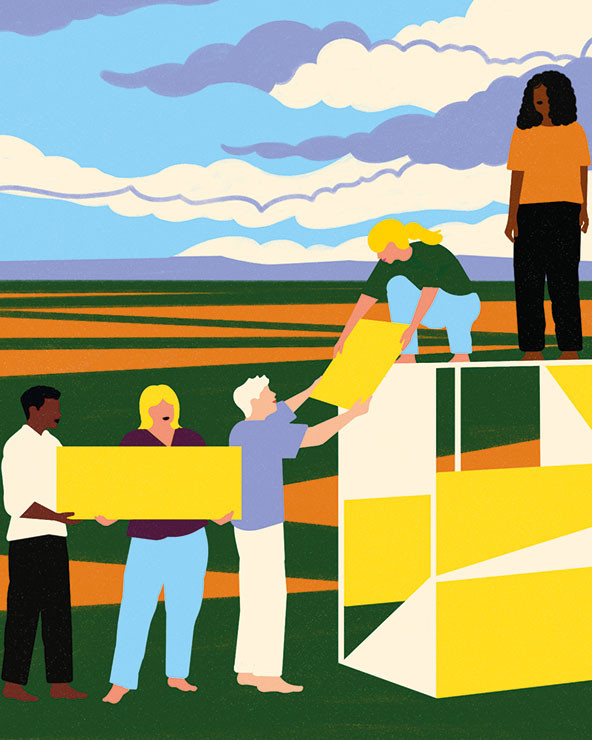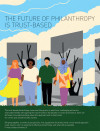 (Illustration by Andrea Mongia)
(Illustration by Andrea Mongia)
When Jamie Allison joined the Walter & Elise Haas Fund in 2018 as executive director, she wondered, “Where have I landed? How do I lead here? Where is the center of gravity in this place?”
The Future of Philanthropy Is Trust-Based

The trust-based philanthropy movement has grown in rapid time, but there are still basic misunderstandings about this approach and its bold vision for a more just and democratic society. This supplement illustrates what a trust-based approach really means, why it is essential to effective philanthropy, and what will be possible if more funders embrace it. Sponsored by the Trust-Based Philanthropy Project
Trustees had similar questions as they wrestled with their desires to fund in deeper, bolder, and more effective ways. It was during this time––amid an executive transition and a board shift from the family’s third to fourth generations––that the board of directors embarked on a process of reflection. Jennifer Haas, a fourth-generation board member and former board chair, remembers those days and the slow transformations spurred by questions about how to operationalize trust at the fund while contending with the organization’s history and building for the future. Today, at 71 years old, the Walter & Elise Haas Sr. Fund is changing.
In recent years, we have engaged more deeply with our program partners to identify moments when we operate from a place of habit instead of intentionality. With greater curiosity, we have been asking questions that lack simple answers. Deeper listening has led to greater clarity, including about how we must work differently to do our work well.
We recognized early that these processes might point our foundation in new directions. We asked ourselves, “Given our resources, knowledge, and strengths, how can we be the most effective grant maker and changemaker in our community?” As our conversations continued, we arrived at the realization that we had to become a different type of funder, embracing a full commitment to equity and justice, rooted in trust.
Beneath the Grantmaking Surface
In 2020, COVID-19 and uprisings for racial justice brought urgency to reexamining the fundamentals of our work. Although we were funding efforts that advanced racial justice, we knew that our commitment had to become more explicit, and it felt important to deepen our understanding of our grantmaking practices. As part of this process, trustees identified four values to serve as guideposts for our work: family, possibility, shared responsibility, and belonging. We conducted a justice, equity, diversity, and inclusion snapshot of the previous five years of the fund’s grantmaking and a 15-year review of the foundation’s capital grantmaking.
The findings revealed that we were making little to no capital investments in neighborhoods with large populations of color, including Oakland, the Mission, and Bayview-Hunters Point, despite being a foundation with a historic focus on the Bay Area. They also showed that most of the foundation’s large endowment and capital grants were going to large, white-led cultural institutions and universities. To address the disparities in our findings and to better support our nonprofit partners, we introduced three significant shifts in our grantmaking:
From silos to integration | We created an integrated portfolio called Economic Well-being to reduce the racial and gender wealth gap. Our integrated approach addresses the interconnected nature of structures, policies, and practices to create a more sustainable economic outlook for future generations. In breaking down silos between our grantmaking-program areas, we aim to meet individuals and families where they are in their lives while transforming the structures that drive intergenerational poverty.
From symptoms to solutions | COVID-19 and the national reckoning around systemic racism catalyzed new conversations about the effectiveness of philanthropy in times of crisis. While we are proud of how we showed up to support our community during the tumult of the last three years, we are now shifting to a more proactive approach that seeks solutions to problems before they reach crisis levels, including funding organizations that work within systems that create the cycle of poverty, from education and criminal justice to government and the workforce.
From contributions to commitments | Traditionally, philanthropic contributions have served as evidence of support of a grantee’s mission. Their scope, duration, and impact have been limited, however. To support nonprofits more effectively, we are shifting to long-term partnerships characterized by shared responsibility. Our new grantmaking approach is to make larger and longer general operating grants, which nonprofits have identified as critical to their sustainability. Establishing committed relationships with organizations provides opportunities to build honest, trusting partnerships.
New Roles, New Possibilities
The Haas Sr. Fund is not the first philanthropic organization to recognize that some conventions related to foundation staff roles are outdated, such as the separation between program and administrative roles. As an extension of our shift from silos to integration, staff now works in matrixed teams that include program and administrative leaders working in partnership. For our largest grants, the fund’s director of administration conducts financial due diligence and shares her report with the fund’s program lead and with the grantee. Grantees have expressed deep appreciation for relieving them of this burden and have begun to use the fund’s financial diligence reports internally. Old models shape how grantee partners are supported, where foundations spend the bulk of their time, who leads, and more.
As part of our process of change, we have created staff roles that embrace a different view of the work and the structures that support it.
In conventional foundation models, program staff are regarded as experts and gatekeepers of resources. But at the fund, we have reoriented program work to focus on facilitative leadership: listening to community and inviting community voices to influence our work. We embrace mutual learning and interdependence and view community members and nonprofit leaders as experts.
To help us learn in ways that are grantee-partner focused, we created the new staff position of strategist for justice, equity, and learning. This role helps us adopt our grantees’ goals as our own, monitor progress in partnership with our grantees, and share mutual learning with one another. While grantmaking remains a function of the Fund, it is done alongside other core work, including organizing funders, convening grantees, sharing our approach, and amplifying grantee wisdom.
To apply a reparative lens to our grantmaking, we created a task force made up of staff members. With the task force’s work as a guide, our staff decided on capital-grant recommendations to bring to the board. Staff working together in this cooperative, non-siloed, cross-program, and cross-functional way was a different experience for us. This approach, which includes program leads; the grants manager; the strategist for justice, equity, and learning; and the director of administration, among other staff, requires the same trust and collaboration internally that we seek to build externally in our relationships with the community. The premium is on listening, compromise, sharing power, and recognizing the wisdom of the collective.
Another area of change is our board dockets. As at other foundations, the docket became a way for program staff to demonstrate value and expertise; the longer and more detailed their memos, the more they felt they were being respected and heard. But we realized that the opposite was the case: The memos were indigestible. More important, they were symptoms of an academic, transactional approach to grantmaking that prioritized process over impact and lobbying the board over learning with them. As a result, the docket has become shorter, focusing on elevating major themes across issues and grants. For staff and board members, this shift has clarified the intersections of our work as well as our mission. The board transitioned from approving grants individually to approving them as a slate.
From Operationalizing to Transforming
We discovered that our grantmaking needed an overhaul to better align with our values and give our partners more room to do their work, experiment, invest, and win.
The Endeavor Fund is our most significant philanthropic investment to date. We awarded $3.5 million each to seven leading nonprofit organizations over seven years, for a total investment of $24.5 million, with the aim of closing the racial and gender wealth gap. This multiyear initiative enables organizations led by people of color to determine the best ways to deepen and grow to change systems. We acknowledge and encourage the importance of investing in organizational capacity, including worker pay and professional development.
Multiyear unrestricted grants are still not the norm. Even for those who embrace a multiyear approach, the average term is two to three years. Allison recalls being at a grant maker conference years ago and watching the audience members’ jaws drop when Pia Infante, a senior fellow at the Trust-Based Philanthropy Project, proposed that future grant periods be 10 years. “The shock for the audience—myself included—tells me how critical it is for funders to push ourselves and one another to share the ideas we have not yet seen proven, especially when our nonprofit partners are telling us what they need to do their work.”
The conventions of status quo philanthropy—working in programmatic silos, imposing rigid requirements that overly rely on transactions, written proposals, and reports—once offered predictability in our grantmaking cycles, comfort in our positional power, and recyclable templates. They required less of us and, in turn, resulted in less impact and fulfillment. Our work today requires us to be active, engaged partners, and our relationships are rooted in trust, not control. Our accountability is to all our partners—our community, staff, and board.
During our journey to operationalize trust, we continue to learn lessons about what this work requires. Rather than a hard pivot, operationalizing trust can be an evolution. This transformation is well worth the effort if our goal is to bring about change and support our nonprofit partners to build a more equitable, trust-based future.
Support SSIR’s coverage of cross-sector solutions to global challenges.
Help us further the reach of innovative ideas. Donate today.
Read more stories by Jamie Allison & Jennifer C. Haas.

